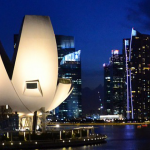Australia’s mixture of relaxed visa laws, strong job prospects and links to the fast-growing ASEAN economies is making it a hit with international MBA students. The sun-soaked country is perceived to be the fourth most welcoming for foreign business students behind the US, Canada and UK, according to a study by researchers CarringtonCrisp.
The study’s author Andrew Crisp noted that many factors influence students’ decisions of where to study — “including cost, ease of access to study visas, the sense of adventure, and an attractive lifestyle”. The latter is, of course, one of Australia’s fortes. Melbourne, for instance, has consistently been rated as one of the world’s most liveable cities.
The University of Sydney Business School recently launched a full-time MBA program that is open to internationals, just as foreign students begin to warm to the country known for its relaxed visa regime. “There are no barriers to studying here on a full-time basis as far as we are aware,” says the school’s MBA director, professor Guy Ford.
Most internationals are eligible for a student visa in Australia, provided they have sufficient funds to cover their tuition, travel and living costs, and are proficient in the English language. On graduation, they can apply for a 485 visa, which enables them to stay in Australia for 18 months to gain work experience.
However, for international MBA applicants note that in order to be eligible for the 485 visa — also known as the “Temporary Graduate Visa — they must have studied in Australia for at least 16 months. So that means for international applicants hoping to secure one of these visas, doing a quick, one-year MBA will not be enough.
Alternatively‚ if they find an employer to sponsor them, MBA grads also can apply for a 442 visa, which enables them to work for up to two years, and which provides a pathway to apply for permanent residency.
Australia: ‘a strong job market’ for international MBAs
“Australia has a strong job market for skilled professionals and we are well hooked into that through our industry connections, supported by our internship programs and placement capability,” says Ford. “The latest figures we have on international students wanting placements in their country of study sits at around 50 percent.
“Sydney itself is the site of the local operations of many multinational firms and we find that students who have worked in these firms in their home countries prior to their studies often spend time post-graduation in these local entities.”
The latest data from the Graduate Management Admission Council (GMAC), which administers the business school entrance test the GMAT, show that demand for MBA talent is strongest in Asia Pacific, where 90 percent of employers plan to make MBA hires in 2018, more than the 81 percent of employers globally who will hire MBAs this year.
MBA internships also are most prevalent in Asia Pacific, where 65 percent of employers plan to offer them in 2018. In addition, 36 percent offer signing bonuses — an average of $3,500.
Many students flock to Australian business schools as a springboard to careers in the dynamic and fast-growing Asian economies, such as Singapore and Hong Kong. Australia’s close time zone to these fast-growing nations is also attractive. of time zones as well as land is attractive.
Romana Garma, director of learning and teaching at Victoria University in Melbourne, says: “Most students come to Australia to study. Some students gain employment and others stay because they become attached to the Australian lifestyle. There are other students who are appreciative of their education, return home and want to share what they have learnt and contribute to their own society. As our MBA is also offered in Malaysia, we also have a large cohort of alumni who are working in Southeast Asia.”
See all MBA programs in Australia
Australia, a resource-rich nation, is perhaps best known for its mining and metals industries, but Garma says: “There is strong growth in professional services. Health and education are also important. With more and more startups, graduates of MBAs are creating their own futures and using their new-found expertise and networks to do that.”
John Shields, deputy dean and head of school at the University of Sydney Business School, says the sectors employing the most of his students are hospitality, real estate, engineering, IT, infrastructure development, logistics, agribusiness and financial services. Approximately 30 percent of the international master’s graduates at the school remain in Australia to work.
“Sydney and Melbourne are sophisticated, post-industrial cities,” he adds. “Australia’s Eastern capitals have strong service sector economies, with solid underlying demand for university-educated knowledge-workers and globally-experienced managers.”
Indeed, since the country is so large and diverse, opportunities can be found in many different parts of the economy. According to data from the Financial Times’ Global MBA ranking, for example, a strong contingent of MBAs from AGSM’s UNSW Business School is currently working in management consultancies, with others in the IT / telecoms industry as well as in media / marketing roles. Likewise, a good chunk of MBA graduates from Melbourne Business School go into consultancy roles.
The diversity of placements aside, Shields says that unlike the US, the Australian master’s (including MBA) market is not oversupplied. “Here, the MBA is seen as a premium qualification, not a ‘volume’ early career credential. Opportunities for both MBAs and specialist post-experience master’s graduates are solid. Australian-based employers are becoming more attuned to the value of hiring them, too.”
So there are plenty of reasons to pursue a post-MBA career in Australia.










